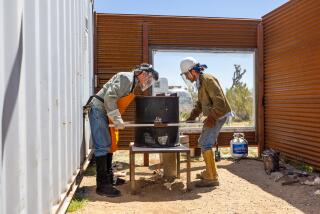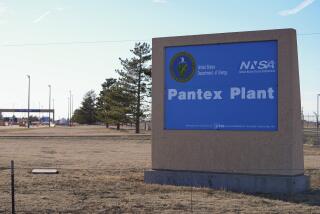Underground Lab Proposed at Mt. San Jacinto
PALM SPRINGS â A mile under a desert mountain near here, scientists envision a labyrinth of underground laboratories, cryogenic chambers and water-filled caverns fitted with devices that can detect some of the rarest matter in the universe.
Mt. San Jacinto is one of four sites under consideration for what would be the first underground laboratory of its kind in the nation, and one of a handful in the world.
âNow it really has gotten to the point where if scientists in the United States want to work in the United States and compete in this field, we need an underground laboratory,â said Bill Kropp, a research physicist with UC Irvine, which proposed the Palm Springs area site to federal agencies.
In the sun-drenched community surrounding Mt. Jacinto, however, some residents and local officials worry that boring a tunnel through the mountain could disrupt its delicate water balance and disturb endangered species on its hillsides.
The labâs portal would sit at the valley station of the Palm Springs Aerial Tramway, which shuttles hundreds of thousands of visitors each year to San Jacinto State Park through Chino Canyon. The area, site of a proposed golf course and housing project and home to an endangered species of bighorn sheep, has long been a sore spot in disputes between environmentalists and developers.
U.S. Fish and Wildlife Service Division Chief Pete Sorensen said massive earthmoving operations during any tunnel construction could disrupt the endangered peninsular bighorn sheep that graze and breed on the mountainâs slopes. Hydrological damage from a tunnel could dry up springs in the canyon, further threatening sheep and other wildlife or plants, he said.
Potential harm to the water table and Native American artifacts makes tribal officials uneasy, said Richard Milanovich, chairman of the Agua Caliente Band of Cahuilla Indians in Palm Springs.
âIt would be almost like drilling into geothermal wells at Yellowstone,â said George Meyer, a geology professor at College of the Desert.
Other locals see the cutting-edge laboratory as a prized project that would boost the regionâs intellectual and economic clout.
âTo introduce this caliber of endeavor into our area allows us to grow into a level we donât currently have,â Palm Springs Mayor William Kleindienst said.
The only existing underground laboratories are scattered from Italy to the former Soviet Union to Japan, forcing U.S. physicists to jet across the world to conduct sensitive experiments.
In addition to Palm Springs, researchers are considering unused mine shafts in South Dakota and Minnesota and a nuclear waste disposal site in New Mexico for a lab. Unlike the other three sites, which offer vertical shafts accessible only by elevator, Palm Springs could accommodate a horizontal tunnel large enough for trucks to drive through, scientists say.
The airport, housing and transportation in Palm Springs also are attractive draws, along with the proximity to major research universities in Southern California.
Kerry Cato, a consultant with Orange-based Earth Consultants International, which is reviewing the site, said modern tunneling techniques could spare the project and surrounding landscape from water damage, but would be more costly than traditional excavation methods.
If Palm Springs emerges as the top choice, scientists say, they will examine ways to minimize disturbance to bighorn sheep, perhaps by limiting the number and times of truck trips during construction.
A committee of physicists convened by the National Science Foundation and the Department of Energy is reviewing whether the U.S. needs such a lab, and where to build it. It plans to present its findings to the foundation within the next month or two. Construction could begin in three years, and would cost about $100 million, said Barry Barish, a Caltech physics professor on the review committee.
A primary purpose of the underground laboratory would be the study of neutrinos, subatomic particles emitted by the sun and supernovas. The elusive neutrinos can pass through the entire Earth unscathed.
On extraordinary occasions a neutrino may collide with another particle and release a burst of energy. This is what physicists hope to detect in a water-filled subterranean cavern, nearly twice the length of a football field and equipped with tubes that amplify light emitted in those subatomic reactions.
âNature is telling us her secrets, but sheâs whispering,â said Randall Black, director of federal government relations and research development at UC Irvine. âThese are very rare events.â
On the surface of the Earth, such an experiment would be swamped by cosmic rays, which can penetrate lead shields but not thousands of feet of rock. Searching for neutrinos in an above-ground laboratory is âlike trying to hear a pin drop at a rock concert,â Black said.
Although the research could yield profound practical applications in the future, scientists say most of the motivation comes simply from a hunger to understand the workings of the universe.
While visible light tells scientists about the surface of the sun, solar neutrinos offer glimpses of the nuclear furnace in its core, explaining how the sun produces energy that lights and heats the Earth.
âTheyâre really kind of nature-driven, curiosity questions,â Barish said.






